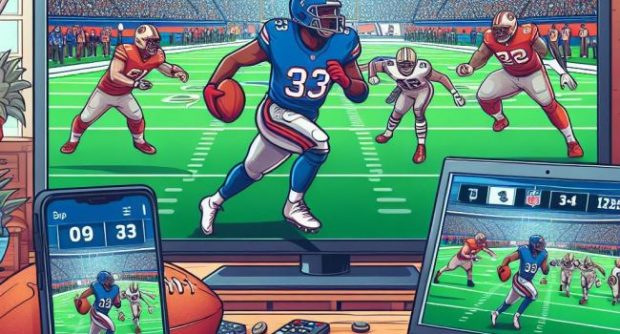Super Bowl LVIII - Sports Media in the Streaming TV Era
by Mathew Broughton on 9th Feb 2024 in News

On Sunday, NFL’s Super Bowl LVIII will be broadcast to a global audience likely to top 100 million. For decades, the annual contest has transcended sporting competition to become a highlight in the entertainment and media calendars.
Acts featured in the halftime show have evolved from The University of Arizona Symphonic Marching Band to the likes of The Who, Beyonce, and Prince, while 30-second advertising slots now command a USD$7m (£5.6m) price tag.
As the Super Bowl changes over the years, so too does the sports television market, with big tech and digital-first streaming companies now vying with their traditional/cable counterparts for broadcasting rights. This tussle came to a head this week in a drama reminiscent of the on-field action, when on Tuesday (6th February), an announcement was made with major ramifications on sports broadcasting worldwide…
In this article, ExchangeWire research lead Mat Broughton crosses the line of scrimmage to unpick the relationship between sports, entertainment, and advertising in the streaming era.
Bringing on the big guns
Once a mainstay of linear broadcasting schedules, sports inventory has become more fragmented over the years with the emergence of satellite and cable television. Broadcasting rights are generally now a melee of ever-increasing price points for lower volumes of matches. Great for leagues and sports stars, less appealing for viewers and advertisers.
The NFL has sidestepped this in a somewhat elegant fashion for the Super Bowl, with domestic rights rotating between broadcasters (currently CBS, Fox, NBC, and ABC) on an annual basis. Nowadays, the rights package includes each broadcaster’s digital streaming platform. This provides an increasingly important pool of viewership, and advertising revenue because, while digital-native platforms, such as Netflx and Amazon Prime Video, have carved out a significant market share in the film and television sector, they have yet to gain such a major foothold in sports.
However, as we discussed last year, the big tech players are starting to make their move. Amazon and Google (YouTube) have followed a playbook of piecemeal portions of popular sports leagues. A Sunday Ticket here, a 20-out-of-380 Premier League matches there. Earlier this month though, we witnessed the biggest move by a streaming firm into sports (or at least sports entertainment) when Netflix announced a decade-long deal with WWE to broadcast its weekly Raw show both domestically in the US and internationally, alongside premium live events such as Wrestlemania.
The entrance of digital streamers to the market represents both an opportunity and a quandary to advertisers and consumers alike. Live sports like Super Bowl LVIII serve as another string in the bow of streamers, but with rights deals having risen in price exponentially thanks to the scale of audiences they attract, a delicate balance is needed. Excessive spending on sports rights could lead to increased prices for consumers in a continually sluggish economy, or lower quality of content if ad subscriptions do not rise to take the load.
For advertisers, shifting sports inventory to streamers, as opposed to fragmented (both by broadcaster and by market) pools, offers them a key ingredient in most marketing plans: scale. The digitisation of sports inventory in general, not just on streaming platforms, represents a potential shift in the evolving relationship between traditional linear and CTV. With many younger demographic groups preferring to consume TV via digital channels, migration of sports content to the most popular digital channels is an additional boon. However, traditional providers in the US have formed an usual form of defence to force a big tech turnover:
The defence - a landmark joint venture
On Tuesday (6th February), ESPN, Fox, and Warner Bros. Discover announced the formation of a unique joint venture (prior to the striking of definitive agreements), whereby their respective sports content will be bundled in a new subscription platform for US-based viewers. The likes of NFL, NBA, motorsports (NASCAR, Formula1), PGA golf, and FIFA World cup contests could now be housed under one roof, at a rumoured monthly price of USD$30-USD$50 (£24-£40). Traditional cable bundles typically combine sports and entertainment (film and/or television) packages, so spinning out their sports inventory and combining it with their competitors’ may take the guide rope away from big tech firms looking to climb into the sector, but equally runs the risk of cannibalising subscribers on their cable packages and individual DTC channels.
That potential audience shift could perturb brands advertising against these individual channels, particularly given when official details around the joint venture’s ad offering remain sparse. Treating the joint venture platform as a separate entity in terms of advertising would appeal to sports-focused advertisers, but would likely irk brands with campaigns running on the individual platforms. Moreover, should one sport prove much more popular than another with viewers, and so too advertisers looking for scale, how do ESPN, Fox, and Warner Bros. Discovery divide the ad revenue pie, taking rights bidding into account? On the latter point, depending on the monetisation model for the service, the service may attract the eye of regulators if they believe the participant networks are unfairly collaborating on rights bidding.
Drama on and off the pitch
2024 has kicked off with a bang in the global sports media business, and it will be fascinating to see how the off-field action pans out alongside the actual matches. Will the new joint venture cool big tech ambitions in sports, or lead to the giants redoubling their efforts? How will the further shift from linear to digital affect advertising budgets around sports? Time will tell. What is certain however, is that sport undoubtedly has the ability to tie global audiences together, in a single moment, that now seems unique in the age of digital entertainment.








Follow ExchangeWire